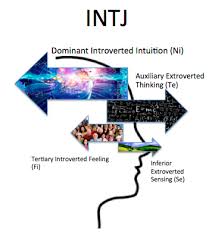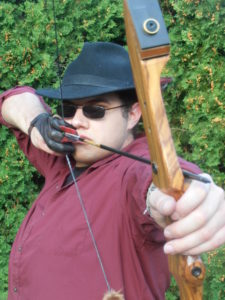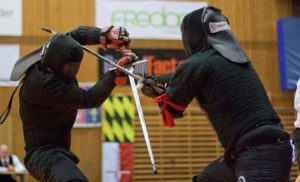Good news, everyone!
So, you want to know what sort of hobbies INTJs have. Well, let me first begin by dispelling a myth—INTJs don’t do anything solely for the fun of it. Every hobby we have serves some sort of purpose, whether it improves us in some way, we learn something, it helps us find “the answer”, or it makes the search for the answer easier. Now, you may be wondering, what I mean by “the answer”, and to some extent, I’m not completely sure either, but the point is that any hobby an INTJ chooses fulfills us in some way, as I’m sure the hobbies of the others types do, but by fulfilling us, I mean it helps us to develop our function stack. Let’s look at this more deeply.
Developing the Functions

The functions of the INTJ are Ni, Te, Fi, and Se (introverted intuition—dominant, extraverted thinking—auxiliary, introverted feeling—tertiary, and extraverted sensing—inferior). But what does it mean to develop or fulfill them? Well, first you must understand what each one does. Ni is responsible for our interest in solving the universe and why we think deeply; Te is what makes us insanely logical and sometimes heartless; Fi is what makes us individuals as well as sympathetic towards the little guy; and Se gives us a desire to explore and experience the outside world, despite what some INTJs might claim. So, to develop or fulfill the four functions, we need to perform actions (hobbies) that engage the functions. We need hobbies that help answer the question “why”; we need hobbies that have an external logic with predictable rules and results; we need hobbies that make us feel unique or help to further develop who we personally are; and finally, we need hobbies that help us to engage with the world.
Point of Interest Regarding Hobbies
When I originally started writing this blog, I decided to focus on the surprising hobbies first because I thought they would be better for holding on to reader interest, but I’ll be honest, sometimes they were difficult to write for, especially for Ni and Fi. But, when I decided to write a few notes for the predictable hobbies (near the bottom), I noticed the exact opposite—they were easy to write for Ni and Fi, but difficult for Te and Se, and that’s when I had a brain wave. I realized that some hobbies are specifically introverted and some are extraverted. I realized that the reason why the predictable hobbies are predictable is because they are introverted hobbies and INTJs are introverts (what with Ni being our dominant function). And I can’t help but wonder if this is true for all introverts and all extraverts—does a person’s most predictable hobby or the hobby they like the most directly relate to whether they are introverted or extraverted? Further, does this mean that introverts seek to make more extraverted hobbies introverted, such as riding a motorcycle, but doing so alone, versus an extravert making introverted hobbies more extraverted, such as reading poetry but doing so in a group, like slam poetry? I don’t know for sure, but I wouldn’t be surprised if that is the case.
So, with all that in mind, what does that mean for surprising hobbies versus predictable hobbies for INTJs? Firstly, as I said, the surprising hobbies are going to appeal more to our extraverted functions (Te and Se), and the predictable hobbies are going to appeal more to our introverted functions (Ni and Fi). Although, it is also possible that predictable hobbies appeal to our dominant and auxiliary functions (Ni and Te), and the surprising hobbies appeal to our tertiary and inferior functions (Fi and Se). It can further be theorized that hobbies and activities that fall in the middle most likely appeal to our extraverted and introverted functions equally, or that they appeal to the entire stack evenly. And again, I wouldn’t be surprised if this is true for all of the 16 types.
So, let’s go through these and see how often that rings true, starting first with the surprising hobbies, then moving on to the less surprising, and then finally ending with the predictable ones.
Surprising Hobbies
Fitness
First up on the list is fitness/exercise/working out. You might think there’s no way in Hell INTJs would be into fitness due to the fact that they present as overly cerebral, but believe it or not, plenty of INTJs are into fitness. Two female INTJs that follow me on Instagram are fitness addicts, and when I asked on IG what sort of hobbies everyone had, I got a response from a guy who identified himself as a strongman athlete who works out 16-18 hours a week. I myself am partial to fitness, but mostly because I’m out of shape and want to be a sexy beast for whatever poor girl agrees to marry me.

Anyway, how or why does fitness appeal to INTJs? Well, the reason why we’re trying to be fit is because we’re trying to perfect. We’re trying to attain that level of human perfection. After all, our minds are in excellent shape, so why not our bodies? Chasing that ideal of perfection is an interesting blend of the four functions—Ni is the catalyst for perfection, Fi makes sure it is attained (so we’re not proven to be hypocrites), we use Te to ensure we’re following the best strategies on how to get there, and Se is fulfilled as it is the method of how we obtain personal fitness.
Interestingly, I must admit that my theory doesn’t seem to work on fitness, but I wonder if that’s because it’s often a personal pursuit. However, I may argue that Ni and Fi are passive in this pursuit, which would make sense since they are introverted, and it’s actually Te and Se that are most active. Further, I can see female INTJs or INTJ bodybuilders seeing it as more of an extraverted activity as women are more prone to societal pressure regarding body image and the bodybuilders generally try to obtain a certain look. But for me, I know that the ideal is just to be sexy—burn the fat, build the muscle, tone up, and make my future wife’s panties hit the floor. I’m not too concerned with how I actually look, just so long as that is the effect.
Beauty and Fashion
Detractor: “What?! INTJs aren’t vain!”
Actually, we kind of are, but mostly with regards to our intelligence and critical thinking. Anyway, beauty and fashion can totally be hobbies of ours. I even had one woman on Instagram tell me that one of her hobbies was learning as much as she could about make-up, and I personally like to speculate what articles of clothing match with others, although mostly in regards to women. (I want my wifey looking her best!) Now, it is true that INTJs don’t seem the type to be into the whole external image, but again, the pursuit of the perfect ideal is not a train easily derailed. So, just like with fitness, the functions act in a very similar matter: Ni drives the ideal, Te is responsible for learning the best strategies, Fi makes sure the ideal is attained and defines what it is, and Se is responsible for making sure we look and actually are attractive. And just like with fitness, Ni and Fi are passive agents, although, they’re actually more like puppet-masters in this regard, ensuring that Te and Se deliver on what they’re looking for. You might think that’s a load of bull, but believe me, with what little investigating I’ve done into the world of fashion and beauty, there are many rules, statutes, and principles that go into making someone look good, like color matching or how to dress for your body type. There are a lot of details to master.
Cars and Motorcycles
Detractor: What?! But those things are loud and flashy! And material!
Dude, Se is a part of our function stack, so guess what, we might not like to admit it at times, but we can be materialistic (so long as it doesn’t break the bank), and we are natural showmen. Case in point: this blog and the fact that I’m indie author. (I also adopt a persona whenever I have to perform in from of others.)

But anyway, cars and motorcycles can appeal quite strongly to INTJs. For instance, driving a car is a tactile experience, whether it be the feel of the wheel in your hands, feeling the car move around you as you corner, being pressed into your seat as you accelerate, or hearing the roar of the engine. And all of that is accentuated on a motorcycle since the engine is right under you and there is less vibration dampening. So, cars and motorcycles easily fulfill Se, and do so strongly, but what about the other functions?
Well, as I’ve mentioned, Fi is concerned with individuality and making sure your own personal beliefs aren’t violated. Depending on the sort of image you’re trying to paint for yourself, you could end up with either a Dodge Charger SRT or a Toyota Prius. As for Te, it’s satisfied when you find yourself in a well-engineered automobile with great styling, and that doesn’t break the bank. As for Ni, well, it’s sort of involved with the other three: it’s mixed up with Te in that you have an ideal for what “well-engineered” is as well as how much you want to pay, it’s involved with Fi in that you’re trying to craft an image for yourself regarding your morals, and it’s involved with Se in that you’re seeking a certain sort of idealistic experience, either smooth and sharp or loud and rumbly. And again, just like with beauty, fashion, and fitness, Te and Se are the functions most easily fulfilled here.
Firearms and Archery
Detractor: What?! But firearms are loud! And shooting archery requires you to go outside!
Yeah, we don’t mind going outside so long as no one else is around. As for firearms, who doesn’t like a big boom?
But, seriously, the way either fulfills our functions is quite simple. Starting from the bottom, shooting either a gun or a bow is quite the tactile experience. With guns you have the feel of steel barrels, and wood and synthetic stocks and grips, there’s the feel of the recoil, the smell of burning powder, the sound of the shot going off, the sound of the gun racking another round whether it be by pump, lever, revolver, bolt, or slide, and then there’s the exhilaration of seeing the target get hit. As for archery, you have the feel of the bow’s riser and string, the arrow’s shaft and its fletch, the feeling of the snap of the string as you release, the jump of the bow in your hand, the sound of your fletchings as they streak through the air, and again, the joy of seeing the arrow go exactly where you wanted it.

Going on to Fi, you may take up guns because you believe an armed citizenry is a free citizenry, or that everyone should know how to defend themselves. Alternatively, you may hold neither of those viewpoints and think guns are barbaric, hence why you shoot archery. Or maybe you believe that hunting helps keep wildlife populations under control. Additionally, you may just think either is a cool skill to have, and you want to be cool, so you practice them. As for Te, well, the science and math that goes into producing a gun or a bow is quite incredible, never mind the math, science, and rationale needed to fire either one well. Shooting a bow or a gun can be pretty intellectually stimulating, especially if you have to correct your shooting technique or you’re trying to figure out a malfunction. And then there’s all the technical aspects of making your own arrows or reloading your ammo.
And finally, we come to Ni, which can serve in two ways. One is by perceiving the truth of firing a gun or bow, looking to see if either is as actually barbaric as some claim, and Ni can be used to help give us a meditative state of mind when we get in the groove of shooting. If you disagree, clearly you have never read Zen in the Art of Archery. There comes a point when the shooter/archer, the weapon, and target all cease to be and become one unified towards a common goal. Perhaps this is the truth we are trying to perceive.
Dancing
Detractor: What?! I’ve never seen an INTJ dance!
You most likely haven’t, and if you did, you didn’t realize it was an INTJ dancing. One of the things about INTJs and their hobbies is that we don’t usually allow people to see how rubbish we are at something. We take up a hobby and then practice in secret until we get real good at it. Like, expert levels of good, and then we show everyone else. And so, too, it is with dancing. It’s one of those hobbies that makes a lot of use of Se, hence why we’re less prone to be attracted to it, but that does not mean we are immune to its appeal. The human body is meant to move, so is it any wonder that anyone finds joy in moving their machine? We hear the beat of the music, we move our feet, and when it is all said and done and we’re tired, a shot of dopamine is sent straight to our brains. One of the things I like about dancing is it’s supposed to help attract a mate, and when one is attracted, you can learn partner dancing, and what’s better than getting sweaty and exhausted in close proximity to the one you love? (Man, I am one thirsty INTJ.)
This is shuffling. I can actually dance like this, although not this well.
So, what about the other functions? Well, a part of dance is the spectacle—the performance—which Se is responsible for pulling off, but it does so under orders from Ni as it’s the function that’s dictating what the performance should look like and the emotion it hopes to invoke. Following with Te, some dances are very technical and require proper form. Sure, a well-choreographed performance just looks like one or two people having fun getting jittery, but that’s the point. You’re not supposed to notice the technical difficulty that goes into such a performance. As for Fi, well, again, an INTJ may be going for a certain image for themselves, such as that of a Renaissance Man or a classy socialite from a bygone era. No one expects the Head of the Intelligence Department or War and Tactics Department to be able to dance, but they’ll break it out when the occasion calls for it. It is a rather nice skill to have at big parties or social events like weddings and parties.
Less Surprising
Cycling and Bowling
I realize that cycling and bowling are two different animals, especially in terms of their costs to enter (bowling is much cheaper to get into), but they both appeal to INTJs in similar ways. For starters, it isn’t required for them to be team sports. Sure, you can do both competitively, but even then, the teams are small. Although, most of the time when an INTJ gets into either, they either prefer to do them alone or with one select person. Further, both experiences are teaming with Se related experiences, which sort of confirms my theory above, but I’ll touch on that more in a second. For Se experiences you have the touch and feel of your equipment, the sounds made whether it’s a ball crashing into pins or the sound of your cassette clicking away, there’s the physical fatigue felt in your body, and the environmental factors. Cycling gets you outside in nature, and while you’re mostly going to be listening to the wind, you may be in a forest with birds and squirrels, or on a street with bustling traffic. As for bowling, you have the sound of others bowling or even cosmic bowling. Sure, long term exposure will be exhausting and irritating as the flashing lights will distract you, but in small amounts, it’s quite fun.

So, what about the other three functions? Simple, INTJs always want to do their best or be the best, so Ni is fulfilled there as they try to match the ideal athlete for either, Te is fulfilled in that a part of performing well in either can be extremely technical, whether on an MTB trail with lots of roots, berms, and jumps, or in bowling where you’re working on your steps, how and when you swing your arm, your release, your aim, and whether or not you want to curve the ball, and Fi is fulfilled in that doing well builds our self-esteem. It’s another thing we can add onto the list of things-we-do-marginally-better-than-everyone-else-but-not-as-good-as-the-pros-because-who-actually-has-the-time-to-get-that-good.
Anyway, as I said above, cycling and bowling sort of fulfill my theory in the part where I mention introverts doing something extraverted, but doing it introverted-ly. A lot of people hit MTB trails and it’s usually safer to go with a group in case someone gets a puncture or is injured, and in the case of bowling, bowling nights—or even just a regular Friday or Saturday night—at an alley are huge. Every lane has people at it, most alleys triple as bars and arcades, and part of the fun of bowling is competition with a group of friends. These are both very extraverted sort of activities, and yet, they can be done alone, and INTJs are likely to do them alone. I know because I’ve done them alone (that’s how I know that bowling is cheaper to get into). So, there it is—a practice of extraverted activity being done introverted-ly. Although, I should mention that bowling and cycling can be done alone unlike other extraverted activities, like football and baseball.
Music, Writing, and Art
It’s important here to note that we’re not talking about merely listening to music (because who doesn’t like listening to music) or just looking at art, hence why I have the mention of writing here. What’s important to note is that we’re talking about the creation of something artistic. So, how or why do the arts appeal to INTJs?
Well, let’s start by looking at Se because it is an interesting one because it really depends on the sort of art being practiced. If we’re talking about knitting or sewing, there’s plenty to touch with your hands, but also plenty to see, and it would be the sense of sight most easily fulfilled through something like painting and drawing. Sculpting could help fulfill both touch and sight, and there is plenty to touch in the creation of music, unless you’re creating it in a computer program, in which case, hearing would be the prime sense. As for writing, that would be a combination of sight, seeing what you’re writing, and imagination, as you imagine the scene you’re writing. So, the senses are important to the creation of art, but they’re not necessarily the most important for an INTJ.
Moving on to Fi, an INTJ would use art as a vehicle to express their deepest held beliefs. I know because I have done so. I’ve written characters with the same beliefs I do, and thrown them into conflicts where such beliefs are tested and hopefully, come out the stronger. As for Te, art can be technical. Ever heard of music theory? I don’t know anything about it, but I did watch one of those videos on YouTube where a professional singer reacts to a heavy metal song. In this case, the song was “Awakening” by Unleash the Archers, and in the first minute of the song, the singer said there was a lot of music theory being applied, so, while I don’t understand what it is, I can tell you “Awakening” is a fabulous piece of music and apparently a technical masterpiece.
But take it from a writer, writing is incredibly technical. There are so many rules to remember with regards to grammar, punctuation, and usage, and if you want to write a good story, you have to obey the rules of rising and falling action, character development, plot development, character action, and so forth. Not to mention, you have the categories of genre, which while not a rule per se, it is categorical information that does satisfy Te.
As for Ni, well, there’s a lot to creating art that fulfills Ni. For starters, there’s the fact that when you set out to create an artistic piece, you have an idea of what you want your piece to look like, sound like, and what you want your audience to take away from it, whether it be a lesson, an impression, or a feeling. Ni is the first mover of an INTJ’s art as it gives birth to the idea and Se is the second as it is needed to create it. Perhaps that’s the reason why some INTJs don’t get into art, or why I prefer to think about my stories than actually write them, because Se is required to do all the heavy lifting and it’s at the bottom of the function stack.
Knife Throwing, Whip Cracking, and Fencing (HEMA)
For the last of the less surprising hobbies, let’s talk about some odd ones, such as knife throwing, whip cracking, and fencing, although, in this case, we are specifically talking about HEMA (Historical European Martial Arts). What makes these odd is mostly their rarity. I mean, who wouldn’t want to be able to throw a knife, or crack a whip like Indiana Jones, or know how to use a longsword? But to actually take them up, to commit to them, that shows a real genuine interest—a true passion.
So, trying to understand how these three appeal to the INTJ’s functions is a little weird. Te and Se are the easiest to understand. For starters, all three are very physical and require good use of the senses, especially spatial awareness. When you’ve got a piece of nylon or leather flying around your head at speeds fast enough to break the sound barrier, you really need to be aware of how you move, how your hand is moving, and how the whip moves. Trust me, it hurts when you hit yourself. And HEMA fencing does require you to know how to align your sword edge with whatever you’re trying to cut. As for Te, all three have hard and fast techniques for how to do them well. Fencing requires footwork, knowing which strikes and guards to do when, and how to approach your opponent tactically. For knife throwing and whip cracking, form and technique are also important. You’d be surprised how many people can’t crack a whip when they first try. It’s all about getting that curve or circle in the thong (whip’s body). And you can have horrible form with knife throwing, but you get better results, such as making sure the knife sticks, when you follow your manual.

Ni and Fi are a little harder to get a hold of. One of the things that is easy about Ni is that it tends to be a function that makes its users feel unusual or out of place, and all three of these hobbies are rare or unusual, so they would appeal to people who have Ni high up in the function stack. And when it comes to practicing any of the three, you can almost put yourself into a meditative like state, which will put you into a state where your higher brain can work on more important things to the steady rhythm of whatever your body is doing. Fi is more difficult since none of these activities really appeal to a sense of morality or justice. Whips suck at self-defense (don’t let anyone tell you otherwise), knife throwing in battle is meant to be more of a distraction or harassment than as an actual method for harming your opponent, and while you can open carry a sword in most public places, a gun is a better choice these days for many reasons. Where Fi might be satisfied is that if a person feels they must pursue one or all of these to be true to themselves—versus team sports—then these three can help build one’s identity. I know I feel special to call these my hobbies rather than football because they help set me apart from the crowd, and being different is something I strive for.
Predictable Hobbies
Now, we move onto the predictable hobbies, which according to my theory are more introverted hobbies, but there is something interesting to all three of these categories. Let’s see if you can pick up on it.
Reading
Reading is an interesting hobby because of how it captivates INTJs. For starters, it activates the function combination of Ni-Se. Ni is activated through the need for imagination, trying to produce a clear image of what’s happening in the story, while Se is somewhat activated in that it tries to recreate the world we’re reading about through things we’ve seen, touched, and experienced ourselves, but it doesn’t completely succeed because reading is a mental process and Se is used in physical processes.
Meanwhile, covering what I said about the predictable hobbies being easy for introverted functions, Fi is also fulfilled quite easily during reading. It helps us to identify with our characters, their struggles, and their hopes for success. Fi may also be activated in that as we identify with the characters, we may see traits in them we may want to emulate, and so we adapt them to ourselves. Finally, Te is given the boring job of trying to define the logic of the world we’re reading about and structure it properly. Te may also be used in an effort to ensure the book we’re reading has the qualities of the genre it is listed as, similarly to how we may use it in writing.
Philosophy, Foreign Languages, and Taking Classes (Learning Something)
I’ve grouped these three together under the banner of “Learning Something” because whether we know or understand philosophy already or a specific language, further study or practice of the ideas they represent is an exercise in learning, whether that be about ourselves or someone or something else.

So, how does learning something fulfill an INTJ? Well, Ni is fulfilled in that it looks for the truth in the topic we are studying and trying to apply it to different fields. We do this because we are looking to understand and trying to find the answer. One of the things we apply this new learning to is ourselves, trying to understand ourselves: what we like, what we don’t like, what makes sense, what doesn’t, etc. And all those are practices in Fi as we further define who we are as an individual. Further, the more we learn, the better we feel about ourselves because we feel smarter or more well-rounded. Studying a topic is a practice in self-actualization for us.
Meanwhile, Te is fulfilled by learning the internal logic of the subject and trying to maintain that logic in order to get the right answer. Se is a little more difficult because while it is activated by helping us take in what we need to learn through our vision and when we practice, such as in speaking, neither of those two practices are all that satisfactory for Se. But, it could be theorized that Se is used somewhat through Ni, just like it was with reading, in that it tries to fill in the blanks of our imagination by comparing previous experiences to the new one we are learning about. It may also try to synthetically duplicate the effects of what we’re learning, if we’re learning about subjects like physics, chemistry, or something else easily tactile.
Video Games, Comics, Anime, and Other Geeky Things
This is another group of hobbies that I grouped together because again they all seem to be related to each other, and to a great extent, they’re actually not that different from how the functions are utilized or fulfilled when reading, which isn’t that unusual given that many of them involve reading.
Anyway, Ni is activated as in order to be able to suspend disbelief of the fantastical worlds we’re exploring, we need to leverage our imagination and make ourselves believe these worlds exist. Once that is done, we can allow ourselves to find the ideals and truths of these imagined worlds, and try to find the way those truths apply to our own. This eventually leads to Fi, and again, just like when we read, we empathize with the characters and adopt some of their traits as our own. Te is fulfilled by trying to make sense of the worlds and classify concepts as they are introduced and is utilized in forming tactics when playing games, video or otherwise. Meanwhile, Se is used for both filling gaps in our imagination and to take in what we’re seeing or clicking, such as in video games. This is especially important in action-oriented video games where reaction times and tactics are paramount to survival and style. Additionally, Se does like stuff, and by that I mean Se likes to own things. It likes to have video game consoles and video game collections (as well as collections of the other stuff). It also helps that some games are loud and flashy.
Conclusion
So, in conclusion, what can be said? Well, firstly, this is not an exhaustive list of the sort of hobbies INTJs can have. I left out many things, like pool, poker, walking, hiking, thinking (yes, that can be a hobby for an INTJ), trading on the stock market, and many more. It’s just that these are the sort of things that most people think of when they think of hobbies. It might actually be fairer to say that these are activities that INTJs like to do, because as I said in the intro, INTJs don’t do anything solely for the fun of it or to waste time.
Further, I know I didn’t always examine the hobbies listed here according to my theory, but I felt that my writing spoke for itself and I didn’t want to be patronizing. And I will admit, I sometimes struggled to make unique commentary regarding each individual hobby, hence why I grouped many of them. Although, even then, there were many similarities, such as the similarities between geeky things and reading, or cycling and fitness.
The point that I wanted to make with this blog, besides giving insight into what INTJs like to do for fun, is that whatever an INTJ does for fun or for not is meant to fulfill us in some way. I would like to believe that is true for all the types, but I do fear that many of the Sensors suffer through things they don’t like for contrived reasons. But, getting back to the point, an INTJ’s activities are meant to fulfill him, and help him grow into a better, more well-rounded person…even if his personal library is stacked with books on the occult.
So, what about you? What are your hobbies? Are there any hobbies I didn’t mention that most INTJs are into?
Thank you for your patronage.
Follow me on social media:
FB: https://www.facebook.com/bryanclaesch
IG: https://www.instagram.com/bryanclaesch/
Twitter: https://twitter.com/BryanofAllTrade
Pinterest: https://www.pinterest.com/bryanclaesch/


You’re spot on the cars and motorcycles.
I’m INTJ and am a petrolhead through and through.
I love the dynamic of a vehichle
The way it handles it gives back your feedback and experience and the you’re also in your own little shell. Have been to nurburgring greatest experience ever.
Driven Porsches on Zandvoort ( in my opinion Porsches are the best cars out there. )
I believe Ferdinand Porsche was a INTJ aswell.
Spot on mate.
That’s awesome. I have my 328i and it’s definitely the best car I’ve ever driven. Unfortunately, I’ve never driven a Porsche. I hope to one day. Thanks for the comment.
This article did not surprise me at all. I’ve met countless INTJs that are into fitness, as they are the most likely among intuitives to be in the gym, followed by ENTJs and somehow ENFJs. No sight of INFJs, NFPs NTPs. I’ve also met quite a few INTJs that work in a variety of luxury industries, and INTJs are VERY fashion aware. They will not follow the latest trends, but they are always well put together. There is this perception that INTJs are bums and unaware, but those have not been the data points I have worked with. INTJs are amazing dancers. You will be surprised how someone so stiff will let themselves go harder than those you’d expect.
I am happy this article shed some light on this.
Thanks for your response. I’m surprised to hear that so many of us work in luxury industries, but I do drive a BMW, so maybe it isn’t that weird.